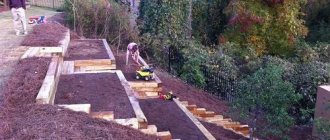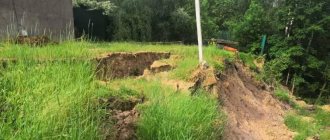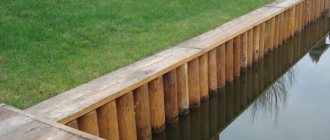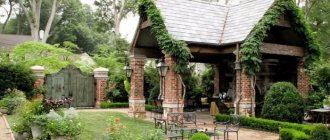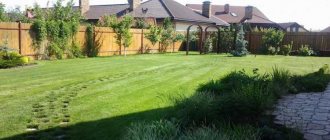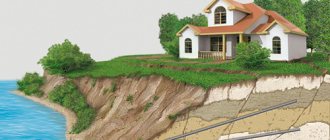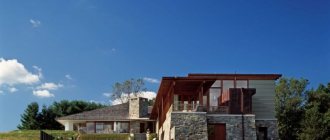Difficult terrain has long ceased to be considered a disadvantage. This is a great chance for experimentation, unusual design and finding new solutions. And for special plants that can take root even in non-standard conditions. Areas on slopes can be played out in different ways. But they will still have to be planted with plants that can strengthen and retain the soil. Special roots are characteristic of a wide variety of species. Some plants will surprise you with their beautiful flowering, others with their leaves, and still others with their growth form. Shrubs, perennials and even trees—there are plenty to choose from.
How to strengthen a slope with plants?
Methods for landscaping slopes
Before selecting plants and looking for interesting solutions, it is worth deciding on the limitations set by the size of the slope, the features of the relief, and the style of the garden. It is better to design the slope as an organic part of the entire project, otherwise it will stand out too much. At the very least, you need to respect the natural or strict nature of the plantings and the general design motifs. And try to find at least 2-3 plants that have already been used in the garden.
Depending on the nature of the composition being created, there are several basic strategies for landscaping slopes, differing in the characteristics of plant selection:
- An array of one type of plant, most often a shrub.
- Complex composition of shrubs and perennials.
- Flower garden or mixborder on a slope.
- Carpet composition, including flowering “waterfalls” and lawns.
- Temporary landscaping with annuals.
The last option is landscaping “as a test, a temporary solution, if it is not possible to plant a slope with expensive seedlings in one season and you first want to take a closer look at color and texture solutions before choosing the final option. Moreover, you can use any carpet and growing annuals, for example, mesembryanthemum or lobelia.
If you plan to walk or climb along the slope that you want to landscape, then a serpentine path, stairs or its equivalent should be arranged before landscaping begins.
If there is a threat of landslides or soil instability, it is worth considering in advance the introduction of reinforcing elements into the design - retaining walls, dividing into terraces, organizing gutters and drainage channels, laying geogrids, geomats, gratings. After all, not a single plant can cope with super-tasks in a ravine. Any “construction” activities should be completed before selecting plant species.
How to take advantage of the terrain
Owners of yards with slopes believe that this area has complete disadvantages. They can easily be turned into advantages if you design them correctly. Professionals claim that areas of this type have the following advantages, which can easily be exploited when organizing the landscape:
- Most of these areas face south. This guarantees active and healthy growth of vegetable crops and ornamental vegetation. Therefore, it is safely allowed to plant such plants.
- If there is a slope not exceeding ten degrees, you do not need to resort to the use of additional means to level the area. And the highest point is allowed to be made in the form of an alpine slide.
- If the living space itself is located on a hill, then you can guarantee that the foundation will not be flooded during floods.
- On such a site you can arrange a high-quality pond with a smooth waterfall. This decor is most common for similar areas.
Beautiful arrangement of plantings Source dachanaladoni.ru
If the owner wants to acquire a beautiful landscape design with evergreen vegetation, he should prepare for frequent watering. The fact is that on a slope, water does not stay well in the ground, and accordingly, the entire decor will turn yellow and dry out.
Decorating uneven areas with stones Source aquagroup.ru
On a note! If the house is located at the bottom of the site, then all the moisture will accumulate at the bottom. This will lead to the formation of dampness and fungus inside the home.
Cottage on a slope Source udachnyi.ru
Successfully managed slope on the site Source aquagroup.ru
Basic criteria for plant selection
When choosing crops for slope landscaping, it is important to pay attention to the key “practical” plant parameters:
- drought resistance;
- durability;
- frost resistance;
- the ability to form dense turf or grow into thickets.
If you do not choose the option of using summer plants “for testing”, there is no place on the slope for plants that degenerate after a couple of years, are prone to freezing, and require daily watering. Conditions on the slopes are specific; water, as a rule, does not linger there, and if you do not plan to take special care, it is better to choose truly resistant crops.
The larger the angle, the steeper the slope, the more powerful plants are needed to strengthen it. Lawns and herbaceous plants will “work” at relatively small angles; on slopes, shrubs and trees are needed.
A very convenient guideline is aggressiveness. If some perennial or shrub has become a torment for you due to the suppression of neighbors, riotous growth, overgrowth, intemperance, then it is suitable for the slopes and can be “relocated” there.
Lighting requirements must correspond to the direction of the slope. When oriented to the west, sun-loving plants are needed, to the north - shade-tolerant, and to the south - also heat-resistant.
The staircase or its equivalent should be installed before landscaping begins.
Shrubs for strengthening slopes
For more than a century, lilac was considered the main plant for strengthening slopes. But not only this favorite fragrant shrub (quite boring after the end of the lush parade of purple panicles) can be used to strengthen the soil even in ravines.
The main flowering competitors of lilac are spirea, forsythia, gorse and broom. Equally unpretentious, easy to grow, at the peak of flowering they seem like a lace haze. The yellow cloud of brooms and Co. or the white arches and pink arrows of spirea can be planted as individual accents, rows, or groups.
Of the universal shrubs for slopes, the first ones to consider are barberries, bladderworts and cotoneasters. You should not discard the option with creeping euonymus, especially since the variegated leaves of their varieties can make any landscaping not boring. But willows (especially creeping and netted), willows (white and scion), mackerel and fieldfare cope even better with the task of strengthening the soil.
Of the conifers, creeping junipers are ideal for the task of strengthening, including varieties of common, horizontal and Cossack juniper. But if you like the textures of microbiota or cypress trees, go for them. And other soil strengtheners - mountain pine, yews and thujas - will help to place large accents.
Willow pear and ornamental quince are a pair of very different, but equally interesting plants for non-standard strengthening of slopes. But they are not the only ones that will be appropriate on difficult terrain. Among the fruit-bearing and useful plants, there are also crops that can replace any competitor in the task of strengthening the slope.
Impenetrable and aggressive common or varietal and large-fruited sea buckthorn, hardy hawthorn, delightfully flowering and indestructible rose hips, blackthorn, serviceberry, viburnum, raspberries and blackberries growing in thickets, graphic hazel, felt or dwarf cherries can grow not only on flat areas.
In addition to the main plants, there are many other species of the shrub-woody group that can settle on the slope and offer an interesting alternative:
- Tartarian, holly, red maples;
- silver goof;
- common hornbeam;
- rowan;
- birch;
- bird cherry;
- white and yellow acacia;
- small-leaved linden;
- ash;
- Staghorn sumac.
If the soil is acidic, on the slope there is a chance to realize the dream of a heather garden, in which you can mix berries and ornamental shrubs - plant Ericas, heathers, lingonberries, cranberries and rhododendrons.
Creeping junipers are ideal among conifers for strengthening slopes
Lianas on the slopes
Many vines can be used both vertically and as an alternative to ground covers. Ivy, with its ability to take root at leaf nodes, is a typical example. The magnificently large slopes are also covered with maiden grapes, the beauty of which cannot be found as a carpet.
In addition to favorites, you can use:
- species clematis;
- wood plier;
- lemongrass
Ground cover roses are an unexpected decoration of the slope. But alone they will not create a full-fledged fortification; it is better to combine them with several ground covers, shrubs, and, in extreme cases, turf perennials.
Decorative perennials suitable for slopes and slopes
The first to come to mind among long-lasting plants for landscaping a slope are always cereals with their dense turf and drought resistance. Fescue and bluegrass are not only lawn grasses; the choice of species is sufficient for interesting solutions. Feather grass, sporobolus, pennisetum, hakonechloa, miscanthus, sedges, and sesleria blue are just a few types of grasses that can be used in protective plantings on difficult terrain. In fact, all cereals growing in dense clumps will cope with their task.
Ferns will surprise you with their beauty and layered effect on a shaded slope. The centipede is an excellent soil filler, but the common grass, scutum, and multi-row grass also grow just as well on a slope with shade.
All universal perennials with dense clumps and interesting foliage are also suitable on slopes. Powerful bushes and pleasing textures will bring aggressive large perennials into the ensembles. Loosestrife, goldenrod, Perovskia, and lupins perform well as soil fixers.
Sage, Byzantine sage, wormwood, Siebold's sedum and other tall species of sedum, milkweed will prefer good light. As well as the more heat-loving liriope muscari. Bergenia (bergenia), apical pachysandra, heucherella, heuchera or tiarella can be planted on the northern and eastern slopes. And mountain weeds, geraniums and mantles are good in any light.
To introduce flowering spots between the main plants, you can use centranthus, gailyard, carnations, geraniums, blue aster, rudbeckia, cornflowers, coreopsis, heliopsis, and in the shade - aquilegia, hellebore, wood aster, astilbe.
Among plants that can grow and develop on the hottest slope, aromatic Mediterranean herbs and shrubs occupy a special place. Santolina, lavender, rosemary, oregano of various varieties, low-growing thymes of all colors and aromas on uneven terrain add a special charm. But the king of the slopes is the aggressive, spreading tarragon. It forms such an indestructible network of roots that even light soil is firmly in its captivity.
Ground covers can easily fill the gaps between the main crops and cover the soil, protecting it from erosion and washout. Or they will create carpet compositions and “flowing” illusions. It would be too boring to limit ourselves to only the already mentioned thymes.
Saxifraga of all types can be chosen to suit your taste. Alyssums, rock sedum and other ground cover sedums, chickweed, speedwell, hawkweed, low bells, variegated nom, budra, heather aster, subulate phlox, clover, grass carnation, pachysandra - favorites with different textures and colors that are easy to match to the style of the garden . And if the slope is shady or you need to fill the soil under large plants, it is also worth taking a closer look at corydalis, rhizome, cymbalaria, periwinkle, hilly weed, phlox, tenacious, chrysogonum and hoofweed.
On a slope and slope, erosion can be controlled even with the help of a lawn - rolled or seeded, from special mixtures for slopes, sown on a geogrid or geotextile.
Sage, Byzantine sage, wormwood, Siebold sedum and other tall types of sedums, milkweed will prefer good light
Retaining walls
Retaining walls are laid out from various materials, but the most ancient, and therefore time-tested, method is the use of stone. The process is quite labor-intensive and lengthy, but the effect of the work done is worth the effort.
Important! The stones are laid without the use of any fastening solutions. It is necessary to select material that matches each other in size.
An easier and faster way is to use a concrete base. In this case, the strength of the structure will be higher.
Cement mortar for supporting walls is recommended for use on steep slopes (slope more than 45 degrees). Such a slope will also require the installation of lighting fixtures. This is necessary for safe “travel” around the site in the dark.
Add accents to a boring place!
Oddly enough, on the slope there is a place not only for plants that can strengthen it. You can safely add a couple of accents to the composition, which will create points of attraction for the eye.
Standard crops, bushes of roses, peonies, a circle of bearded irises placed at equal distances, a few austere dwarf conifers, weeping trees or at least spheres of boxwood - and the design will shine.
Ornamentality, adherence to order and symmetry in the placement of accents is the secret to effective solutions.
Landscape Design Tips
To complete all the work on arranging the design of a yard on a hill, you can take as a rule a few simple but very useful tips from designers:
- If there is even a slight hill on the territory, then in any case it is impossible to do without a ladder.
- All elements should be easy to move, but their harmony with other objects on the site is also important.
- They try to design any paths in the form of a serpentine, so they create a visual expansion of the nearby space.
- For all areas it is recommended to use only natural materials, including stone, paving stones, wood and other popular species.
House on an elevated slope Source landshaftnyi-dizayn.mydiz.biz
Slope with an amphitheater Source www.landshaftny-dizain.ru
House on a slope Source www.magazindomov.ru
Garden crops and a vegetable garden should not be located nearby on a slope. The minimum distance between such crops should be at least 3-4 meters.
Large wooden house Source severny.by
Territory with a swimming pool Source buildercamp.ru

